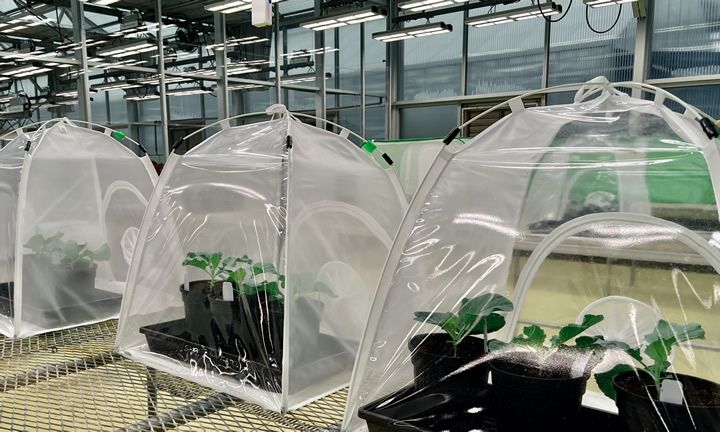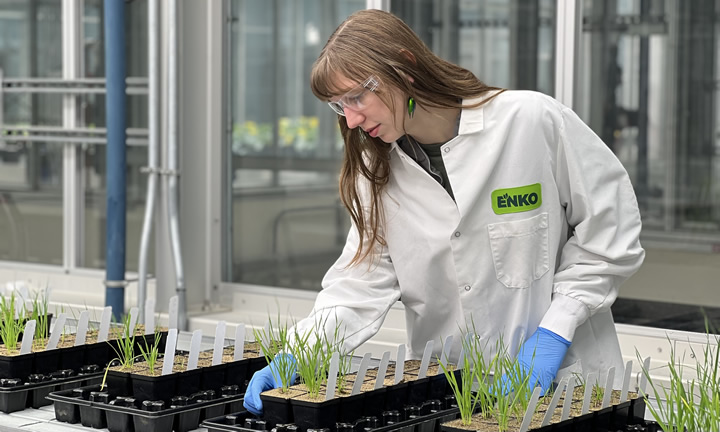While there are a myriad of reasons why farming and delivering food is more challenging than ever before, treatment-resistant insects, disease (fungus) and weeds are primary contributors to the problem.
 How to Fight Back Against the Food Chain Climate Catastrophe
How to Fight Back Against the Food Chain Climate Catastrophe

Jacqueline Heard, Ph.D., MBA, CEO and Cofounder | Enko
The world's food systems are struggling. Severe weather from climate change, wars, pests (weeds, disease and insects), and governmental inefficiencies, among other set-backs are to blame. Together, they have created a global food crisis that is enormously tangled. In many nations farmers are struggling with mounting challenges and declining yields, and people are hungry.
According to the Food and Agriculture Organization of the United Nations (FAO), "Moderate or severe food insecurity...now affects more that 30% of the world's population."
The time has come when we simply must drive a renewed focus on a secure food chain that can thrive despite climate change by building business resiliency and applying various technology and business innovations from pre- to post-harvest practices.
Weeds and Pests Love Climate Change
While there are a myriad of reasons why farming and delivering food is more challenging than ever before, treatment-resistant insects, disease (fungus) and weeds are primary contributors to the problem. All are agile, crafty adaptors that have proven time and time again that they can thrive in extreme conditions.
Globally, farmers today are estimated to lose up to 40% of their crops to pests annually, with plant diseases costing the global economy around $220 billion.
More than 600 species of pests worldwide have developed some level of pesticide resistance and continue to thrive. And some pests have simply adapted to techniques such as crop rotation. Larvae of select species of corn rootworm as example, can now wait years until corn is back in the ground to hatch and begin their destructive activities.
Seasonal shifts - such as warmer winters, earlier springs and hotter summers - as well as spikes in extreme weather, and weather-related natural disasters also disrupt typical life cycles and natural limits that confine certain weeds and pests to select regions. Extreme weather is now spreading seeds and spores, delivering well-known crop diseases to new places that have never dealt with them before. What may have once been considered a region-specific concern, now likely deserves to be evaluated as a global ag threat.
In terms of the fungal food threat, nearly 200 crop pathogen species are already resistant to widely used fungicides. While not all fungal diseases wreak as much havoc as Panama disease has for banana crops, as example, the impact of fungal disease on agricultural productivity spans all global cropping systems, from rice fields in Asia, to wheat in Europe, and soybeans in Brazil. With the emergence of new anti-fungal resistant strains of fungal disease, and varieties that thrive in rising temperatures, farmers urgently need new solutions.
 When discussing the most critical potential crop threats exacerbated by climate change, it would be remiss to leave out weeds. Weeds like Palmer Amaranth compete with crops for sunlight and nutrients and can destroy crop yield when left uncontrolled. Growers rely on herbicides to control weeds, however, more than 500 weed species are resistant to the most widely used products. Beyond resistance, drought conditions, rising temperatures and carbon dioxide all have a negative impact on herbicide-efficacy.
When discussing the most critical potential crop threats exacerbated by climate change, it would be remiss to leave out weeds. Weeds like Palmer Amaranth compete with crops for sunlight and nutrients and can destroy crop yield when left uncontrolled. Growers rely on herbicides to control weeds, however, more than 500 weed species are resistant to the most widely used products. Beyond resistance, drought conditions, rising temperatures and carbon dioxide all have a negative impact on herbicide-efficacy.
Across all threats, the concern is clear: Farmers urgently need new tools to grow abundant, healthy crops. And they need to readily produce even higher yields as food demands rise for the global population, which according to UN estimates will swell to. 9.7 billion by 2050.
Innovation Is Abundant
The positive news is that in response to the problem, companies around the globe are seizing the opportunity to discover innovative solutions using new digital technologies, mechanization, as well as safe pesticides and fertilizers, to help farmers grow larger yields of healthier crops. Sifting through the latest FoodTech 500 report, which highlights top innovators based on thousands of applications from agtech and foodtech companies across 50 countries, there is no question that the need for innovative solutions is being recognized around the globe.
On the farm, water sensing systems, climate alerts and soil monitors will inform farmers seeking to farm efficiently and sustainably, but stopping pests and disease from decimating crops is the most significant lever to increasing farm output and food supply. Getting new, safe, and effective crop protection tools into farmers' hands quickly will lead to higher crop yields, and lower food prices for consumers.
Regulatory Challenges
In the United States and around the globe, the studies required by regulators to demonstrate the human and environmental safety of new products take years and cost tens of millions of dollars. Despite the urgent need for intense innovation, regulatory review processes are, for safety reasons, long and complex. This has made the path to market for new treatments painfully slow - and farmers and consumers pay the price in the form of lower yields and more expensive food while they wait.
Regulatory protocols are massive hurdles for innovation, resulting in the fact that many of the pesticides and herbicides farmers use today are the same ones their grandparents used. Under current protocol, a discovery made today might not be available until 2033, or later. In addition to limiting options for farmers, it also means weeds and pests have had decades to develop resistance to approved products.
Food security is a world health emergency that warrants a significant shift in the way we manage regulatory approvals for new technologies.
Safe Solutions Should Target Only the Problem Pest or Weed
Sustainable, safe solutions that target specific weeds, diseases or insects with new modes of action to effectively keep populations under control are an essential element of the next phase of crop protection. The need to protect the environment while controlling resistant and invasive insect pests that decimate entire crops without discrimination will continue to be a primary concern.

Tap the Power of the Predictive
Although innovators cannot directly influence regulatory requirements, predictive power is where they can help bring much needed crop protection solutions to market quickly, without compromising safety.
Enko, as example, uses proprietary algorithms and tools to discover new agricultural product innovations and predict their safety profiles early and at each stage of commercial development. This early safety check puts protective guardrails on crop protection innovation so researchers can focus on farmer and environmental benefits of novel crop protection compounds that have the highest chance of performing well in regulatory studies.
Prioritize the Most Damaging Crop Consuming Pests, Weeds and Diseases
Companies and regulators can move fast - they've done it before. By implementing an emergency use authorization in 2020, the FDA authorized the research for and use of the first COVID-19 vaccines less than a year after the World Health Organization declared a pandemic.
The world is desperate to apply this same urgency to reviewing new crop protection compounds for farmers. We can start by identifying the top threats - specific pests, weeds, and diseases - and then adding the ability to employ emergency use authorization protocols to prioritize solutions to those threats. Tapping Al advances like predictive toxicology platforms could further streamline the review process and help speed critical solutions through approvals to ensure farmers can get access to the solutions they need to thrive.
Similar to the acceleration of the development and distribution of vaccines and disinfectants to help curb the COVID-19 pandemic, the U.S. government could seize the opportunity to magnify the speed at which new solutions can come to market to increase the production of food around the world.
Looking Ahead
Responding to the global food crisis will require innovation throughout many areas along the food supply chain, but ensuring farmers can grow abundant, healthy crops is a crucial first step to stabilize the food supply and bring down costs. We look to innovative agricultural companies that are applying new tools and technologies to protect the world's food supply, beginning on the farm.
Enko, as example, is working to cut years off the development process by applying an Al-driven model to comb through proprietary encoded DNA libraries containing billions of likely candidate chemical compounds to find the ideal solution for a specific threat. The company has already generated hundreds of new crop protection molecules and is currently progressing eight product programs through the pipeline with more to come. Enko is dedicated to creating products that are good for people and the planet, helping growers cost-effectively adapt and mitigate key challenges to the food supply chain around the world.
There is hope. Working alongside regulators, innovators will be able to strengthen frontline farmers by speeding a much-needed evolution that can, in turn, safely and sustainably increase food production that can feed the world.
The content & opinions in this article are the author’s and do not necessarily represent the views of AgriTechTomorrow
Comments (0)
This post does not have any comments. Be the first to leave a comment below.
Featured Product

